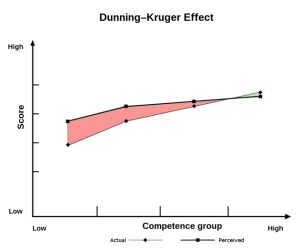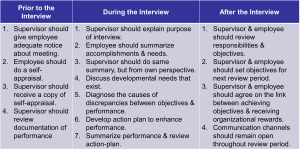7-5: Issues Impacting Performance Management

Social-Psychological Context of Performance Management
Performance management represents complex social-psychological processes where communication occurs within specific social contexts. Early researchers focused primarily on rating scale formats believing accuracy was the primary appraisal goal. Contemporary approaches recognize that social context makes performance management complex, with accuracy being just one component of effective systems.
Here’s something that might surprise you: the “best” performance management system on paper might be completely ineffective in practice if it doesn’t account for human psychology and organizational dynamics. It’s not just about having the right forms and processes—it’s about understanding how people actually behave in real workplace situations.
Reaction Criteria
Both evaluator and employee reactions to performance appraisal processes represent important system effectiveness indicators. Reaction criteria might better indicate performance management system effectiveness than technical measures like accuracy. Technical accuracy becomes irrelevant if everyone hates the system and refuses to use it properly.
Think about it this way: you could design the most scientifically valid performance measurement system in the world, but if managers find it too complicated to use and employees think it’s unfair, it’s not going to help anyone improve performance.
Both appraisal characteristics and organizational factors impact satisfaction, justice perceptions, and other reaction criteria. Reactions include satisfaction, perceived accuracy, motivation to use feedback, and anger levels. Research shows employees report less anger and higher justice perceptions when ratings are well-justified.
Performance appraisals viewed as unfair relate to employee emotional exhaustion, representing one class of “neglected criteria” that might be critical to appraisal success.
The Dunning-Kruger Effect
The Dunning-Kruger effect represents a cognitive bias where unskilled individuals overestimate their abilities and lack self-awareness to realize their limitations. This phenomenon occurs because the same knowledge required to perform a task well is often the knowledge needed to recognize one’s own lack of competence.
As a result, individuals with lower ability not only make more mistakes but are also less likely to recognize those mistakes or seek improvement. This presents a significant challenge in performance management, as these individuals may resist feedback, deny shortcomings, and perceive evaluations as unfair or inaccurate.

For example, an employee who consistently misses deadlines and produces subpar work may still rate themselves highly in self-assessments and reject constructive criticism from supervisors. Such miscalibration can hinder development efforts and reduce the effectiveness of coaching and feedback interventions.
Addressing the Dunning-Kruger effect requires tactful communication, clear performance metrics, and structured feedback mechanisms that help individuals calibrate their self-perceptions with reality. It’s like helping someone realize they’re not as good a driver as they think they are—it requires patience, concrete examples, and a lot of diplomacy.
Supervisor-Subordinate Relationships
Leader-Member Exchange (LMX) theory shows that supervisors develop different relationship types with different employees, and these relationships affect performance appraisal processes. Employees with favorable LMX relationships and frequent communication receive higher ratings than counterparts regardless of objective performance levels.
This makes intuitive sense—we tend to evaluate people we like and trust more favorably than those we don’t, even when we’re trying to be objective. It’s human nature, but it can create unfairness in performance evaluation if we’re not careful.
Organizational Politics
Organizations are inherently political places where politics and self-interest play appraisal process roles. People make deliberate attempts to enhance or protect self-interests when different action courses are possible.
Impression management strategies control behavior to make good impressions on others, while supervisors also engage in impression management. Executives might manipulate performance appraisals for political reasons. Politics in performance management isn’t necessarily bad—it’s simply reality.
The key is recognizing that politics exist and designing systems that minimize their negative effects while acknowledging that you can’t eliminate human nature entirely.
Trust and Justice
Trust represents how much evaluators believe that fair and accurate appraisals have been and will be made in their organizations. Trust relates to employee acceptance of and confidence in management. When processes are trusted, they get used more effectively, and performance management can serve as a tool to enhance organizational trust.
Managers who feel they’ll remain with organizations long-term are more able to make accurate appraisals beneficial to long-term organizational functioning. Managers with less job security tend to be lenient because leniency helps maintain short-term peace. It’s like the difference between a coach who’s building a program for years versus one who’s just trying to survive this season.
Justice perceptions significantly impact performance management effectiveness. If evaluators or employees perceive appraisal processes as unfair or biased, technical quality becomes irrelevant. Implicit Person Theory (IPT) shows that supervisors who believe people can change are perceived by employees as more just in their appraisals.
This is fascinating—employees can somehow sense whether their manager believes they can improve, and this affects how they perceive the entire evaluation process.
Participation and System Knowledge
Participation can include self-assessment or expressing ideas during appraisal sessions. A meta-analysis by Cawley et al. (1998) showed strong positive relationships between employee participation in performance appraisal processes and employee reactions including satisfaction with systems and sessions, motivation to improve, belief in fairness, and belief in usefulness.
Perceived System Knowledge (PSK) represents how well employees understand appraisal systems. PSK has important effects on appraisal processes like supervisor-employee agreement and positively relates to job attitudes and appraisal reactions.
It’s like the difference between playing a game where you understand all the rules versus one where you’re constantly confused about what’s expected. When people understand how they’re being evaluated, they’re more likely to accept the results and work to improve.
Legal and Ethical Considerations
Performance management systems must comply with various federal laws addressing fair employment practices. Discrimination can occur in performance predictions and job behavior evaluations, making legal compliance essential for organizations.

Federal Legislation
Key legislation includes Title VII of the Civil Rights Act of 1964, the Civil Rights Act of 1991, the Age Discrimination in Employment Act (ADEA), and the Americans with Disabilities Act (ADA). These laws protect individuals against discrimination based on race, color, religion, sex, national origin, age, and disability status.
Courts have established several criteria for legally sound performance appraisals. Content should be objective, job-related, behavior-based, within employee control, and related to specific functions rather than global assessments. Procedures should include standardized operations, formal employee communication, information about performance problems with correction opportunities, employee access to appraisal results, written instructions for evaluator training, and multiple diverse unbiased evaluators.
Recent federal updates have introduced significant changes to performance management practices. The U.S. Office of Personnel Management (OPM) has mandated that all Executive agencies adopt a standardized fiscal-year performance appraisal cycle for non-Senior Executive Service (SES) employees beginning October 1, 2026. This initiative aims to improve consistency, compliance, and accountability across federal agencies.
Additionally, federal agencies are under increased scrutiny regarding diversity and inclusion practices. The Equal Employment Opportunity Commission (EEOC) and Department of Labor have emphasized that organizations must frame diversity goals carefully to avoid legal risks under Title VII, especially in light of evolving interpretations of fairness and equity in performance evaluations.
Legal Recommendations
Austin et al. (1995) provided eight legal recommendations for performance appraisal: start with job analysis to develop criteria, communicate performance standards in writing, recognize separate performance dimensions rather than overall ratings, use objective criteria along with subjective judgments where possible, provide appeal mechanisms, use multiple evaluators when possible, document everything relating to decisions, and train evaluators with written instructions.
Research by Werner and Bolino (1997) reviewing court decisions found judgments favoring organizations when job analysis was used, written instructions were clear, employees could review their appraisals, multiple evaluators agreed on ratings, and evaluator training was provided.
The key takeaway? Following best practices isn’t just good management—it’s also good legal protection.
Contemporary Issues and Future Directions
Technology and Performance Management
Technology is revolutionizing performance management approaches in ways that would have seemed like science fiction just a few years ago. Electronic monitoring enables recording vast amounts of data on multiple work performance dimensions, making continuous and detailed performance data collection possible though it might occur without employee knowledge.
Technology also helps with feedback processes by recording and combining performance ratings and written observations, making information available online through various software packages. Imagine having a dashboard that shows real-time performance metrics, feedback from multiple sources, and development recommendations—that’s the direction we’re heading.
But with great power comes great responsibility. Organizations need to balance the benefits of data-driven insights with employee privacy concerns and the risk of creating a surveillance culture that undermines trust.
Cultural Considerations
Performance appraisal systems developed and considered effective in the United States might not work well in other countries or cultures. Performance appraisal is deeply rooted in societal norms, values, and beliefs, reflecting attitudes toward motivation, performance, and relationships that vary dramatically across countries.
Countries valuing assertiveness and personal accomplishment view performance appraisal as ensuring fairness among employees so higher performers receive greater rewards. Countries scoring lower on assertiveness but higher in interpersonal relations might dislike social separation and pay inequality resulting from performance differentiation.
It’s like assuming that what makes a good leader in New York will be the same as what makes a good leader in Tokyo or Stockholm. Cultural context matters enormously in how people give and receive feedback.
Performance Management Evolution
Traditional annual performance reviews face increasing criticism, with approximately one-third of U.S. private companies switching to more informal and frequent manager-employee engagement. This shift reflects greater focus on talent development, business agility, and preferences for teamwork over individual responsibility.
The movement away from annual reviews toward continuous performance management reflects recognition that people need ongoing feedback, not yearly surprises. It’s like the difference between getting your grades only at the end of the semester versus getting regular updates on how you’re doing throughout the course.
Emerging Technologies in Performance Management
Adaptive Goal-Setting Technologies dynamically adjust goals based on real-time performance data, organizational priorities, and external market conditions. These systems can automatically recalibrate objectives when circumstances change, helping employees stay focused on what matters most.
Sentiment Analysis in Feedback Systems uses natural language processing to evaluate written feedback emotional tone. This technology can help identify patterns in how feedback is given and received, flagging potential issues before they become serious problems.
AI-Driven Coaching Platforms leverage machine learning algorithms to provide personalized, real-time coaching based on performance data and behavioral indicators. Imagine having a digital coach that knows your strengths, weaknesses, and development goals, and can provide tailored advice 24/7.
These technologies offer exciting possibilities, but they also raise important questions about privacy, fairness, and the human element in performance management. We need to be thoughtful about how we integrate these tools to enhance rather than replace human judgment and connection.
The “Nice Guys” Phenomenon
Here’s something that might make you rethink conventional wisdom about workplace success. Research by Nyhus and Pons (2004) examining personality characteristics and salary increases for 3,000 Dutch workers found negative correlations between agreeableness and wages—the association was particularly strong for female workers.
The authors suggest two explanations: Machiavellian intelligence (the ability to manipulate others and influence compensation levels) and the possibility that agreeable individuals may be less assertive in negotiating salary increases. This finding aligns with broader research suggesting that traits such as assertiveness and self-promotion are often rewarded in competitive work environments, while traits associated with agreeableness—such as cooperation, modesty, and empathy—may be undervalued in salary negotiations.
For example, a study by Judge, Livingston, and Hurst (2012) found that men who scored lower in agreeableness earned significantly more than their more agreeable counterparts, even after controlling for other personality traits and job characteristics. These patterns raise important questions about fairness and equity in performance management systems.
If compensation and advancement are influenced by personality traits unrelated to job performance, organizations may inadvertently penalize employees who contribute positively to team dynamics and organizational culture. Performance management systems should therefore be designed to recognize a broader range of contributions, including interpersonal effectiveness and collaboration, to ensure that “nice guys” are not systematically disadvantaged.
This research highlights a troubling reality: being genuinely helpful and agreeable might actually hurt your career prospects in some organizations. It suggests that performance management systems need to evolve to better recognize and reward collaborative, supportive behaviors that benefit the entire organization, not just individual achievement.
Conclusion
Performance management has come a long way from the dreaded annual review that nobody enjoyed. Today’s best practices emphasize continuous development, regular feedback, and systems that actually help people improve rather than just judge them.
The key insights for anyone involved in performance management—whether as a manager, employee, or system designer—include the importance of clear expectations, regular communication, multiple perspectives, and recognition that performance management is fundamentally a social process involving human emotions, relationships, and motivations.
As technology continues to evolve and workplace dynamics shift, performance management will undoubtedly continue changing. But the fundamental principles will remain the same: treat people fairly, help them understand what’s expected, give them the support they need to succeed, and create systems that promote growth rather than just evaluation.
Whether you’re preparing to manage others or simply want to excel in your own career, understanding how performance management really works—including its limitations and biases—will serve you well. The organizations that figure out how to do performance management effectively will have significant advantages in attracting, developing, and retaining talent.
Media Attributions
- Performance © Nick Youngson is licensed under a CC BY-SA (Attribution ShareAlike) license
- Dunning-Kruger Effect © Diego Moya is licensed under a CC BY-SA (Attribution ShareAlike) license
- Conducting Interviews
